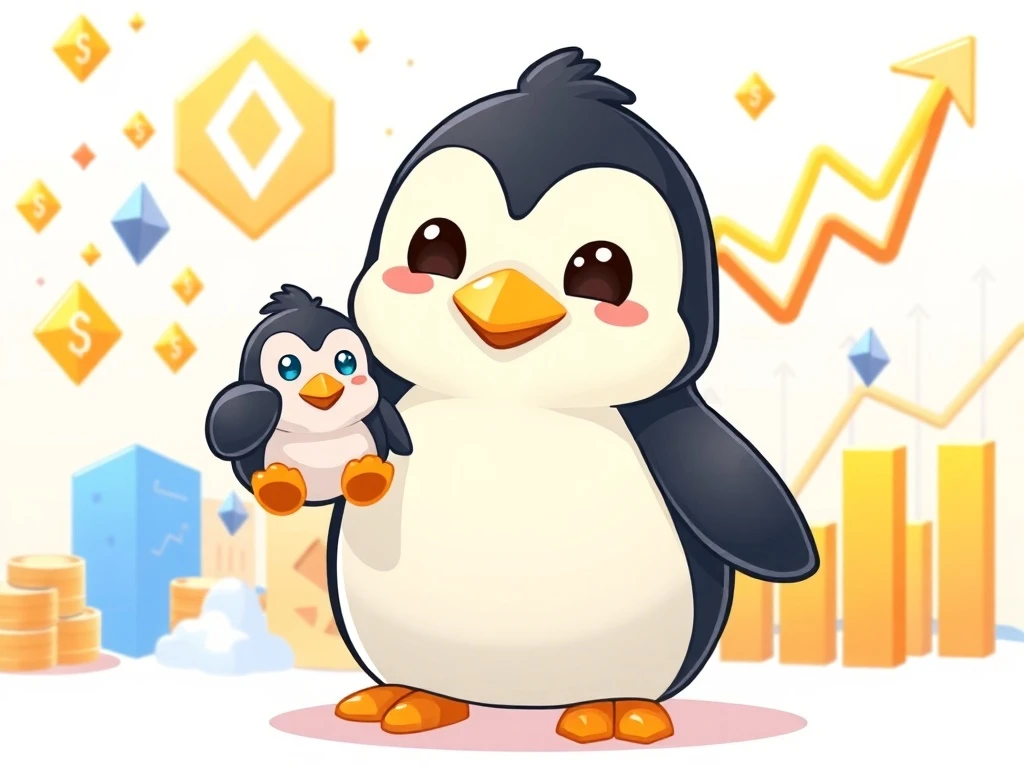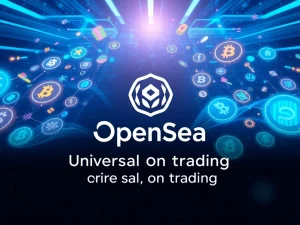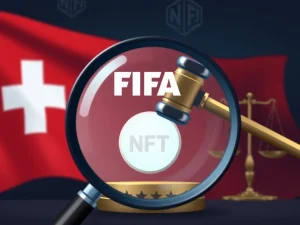Pudgy Penguins’ Triumphant Comeback: How Plushies Ignited NFT Success

In the volatile world of non-fungible tokens (NFTs), survival often proves challenging. Many projects launched during the 2021 bull run have since faded. However, one project defied the odds: Pudgy Penguins. This brand executed a remarkable turnaround, transforming from near bankruptcy to a projected $50 million in revenue by 2025. Their secret? A bold pivot into the physical toy market, proving that innovative strategies can lead to an incredible NFT success story.
The Bold Pivot: Pudgy Penguins’ Near-Bankruptcy Escape
Just three years ago, the future looked bleak for the Pudgy Penguins NFT collection. The project was teetering on the edge of financial collapse. In April 2022, its value reached an all-time low. Amidst this crisis, Luca Schnetzler, widely known as Luca Netz, stepped in. He was already a significant holder within the Pudgy Penguins community. Dissatisfied with the project’s performance, Netz made a decisive move. He acquired Igloo, the parent firm, for $2.5 million in Ether (ETH). This acquisition marked a critical turning point for the struggling brand.
However, Netz faced immediate challenges. The Terra ecosystem collapsed in May 2022, triggering a prolonged bear market across the crypto space. NFT asset values plummeted. This market downturn threatened to derail Netz’s recent acquisition. He quickly recognized the urgency of the situation. “This company is going to run out of money in six months if I don’t start making real money,” Netz explained in a recent interview. He understood that traditional Web3 revenue streams would not suffice. Consequently, he shifted his focus. Netz realized that “Physical products were the only thing I knew how to do.” This insight became the foundation for the project’s survival and subsequent boom.
Luca Netz’s Strategic Vision: A Web3 Toy Brand Emerges
Luca Netz’s journey to becoming a prominent figure in the Web3 toy brand space is noteworthy. His entrepreneurial spirit developed early. He frequently moved during his childhood, which made traditional schooling frustrating. This experience pushed him to seek opportunities outside conventional paths. At just 18, Netz reportedly earned his first million dollars. He achieved this through a successful drop-shipping business on Shopify, selling jewelry. He strategically promoted these products using Instagram fan pages dedicated to popular hip-hop artists. This early success demonstrated his acumen in consumer marketing and e-commerce.
Before his venture into Pudgy Penguins, Netz served as chief marketing officer for Gel Blaster. This company sold toy guns that shoot water gel pellets. Gel Blaster products found distribution in major big-box stores like Walmart. This experience provided Netz with invaluable insights into the physical toy industry, supply chains, and retail distribution. When NFT revenues and the broader blockchain ecosystem spiraled downward, Netz leveraged this extensive consumer products background. He expanded Pudgy Penguins into a physical toy brand. Initially, this pivot merely kept the company afloat. It generated just enough revenue “to pay the bill.” Yet, this strategic move proved incredibly scalable. It transformed into a multimillion-dollar cash cow, fundamentally altering the brand’s financial trajectory.

Instagram’s Unconventional Power for Blockchain Collectibles
Most cryptocurrency projects primarily build their communities on industry-familiar social media platforms. These often include X (formerly Twitter), Discord, and Telegram. Instagram, a platform known for its visual content, is frequently deprioritized by crypto projects. However, Netz saw this as a missed opportunity. He believed this approach did not “make any sense.” While Pudgy Penguins maintains a presence on typical crypto social channels, Netz placed a significantly greater focus on Instagram than most other projects. This decision proved pivotal for the brand’s growth and visibility.
Netz understood the mindset of traditional retailers. “When I go to Walmart or Target, [they don’t care about] the big crypto numbers like NFT market cap, price or volume,” he stated. Instead, he recognized that “The thing that really moved the needle with traditional brands in terms of getting big-box distribution is social media.” As of a recent count, Pudgy Penguins boasted an impressive 1.9 million followers on Instagram. Their X account, in comparison, had 728,100 followers. This disparity highlights the effectiveness of their Instagram-centric approach. Pudgy Penguins’ Instagram consistently features engaging reels. These short videos tell the story of two animated penguins, capturing a broad audience beyond the typical crypto enthusiast. This strategy successfully transformed Pudgy Penguins into a broader cultural brand, extending its reach far beyond the blockchain niche.

From Digital Doldrums to NFT Success Story
Despite its growing social media presence and successful toy line, Pudgy Penguins remains at its core an NFT project. The NFT market has faced declarations of its demise multiple times by various media outlets. According to DappRadar, NFT trading volume continued to fall even after its supposed death. It dipped to under $1 billion in the second quarter of 2025. Major collections like Bored Ape Yacht Club (BAYC) experienced significant declines. BAYC, which once captivated global celebrities and public figures, reached a peak floor price of 153 ETH in May 2022. This peak occurred just days before the Terra crash. The collection has since fallen dramatically, reaching a 13.44 ETH floor price. CryptoPunks, currently the top NFT collection by market capitalization, also saw its floor price drop from an all-time high of 125 ETH in August 2021 to 52.97 ETH today. The market has indeed been challenging.

However, recent excitement for NFTs has started to climb back up. Collections like CryptoPunks and Moonbirds have recorded sales and trading spikes. This resurgence aligns with a broader rise in collectibles’ popularity. Online resale platform eBay, for instance, reported a 6% revenue bump to $2.7 billion in its Q2 earnings call. The company attributed this success to increasing interest in physical collectibles, such as Pokémon cards. Netz noted this trend, stating, “Pokémon is hot right now. You can buy a Pokémon card one week, and then two weeks later, it’s worth double. It’s insane.” He views this as a positive indicator. “That’s a good signal to me that people are starting to kind of explore in collectibles again. When physical collectibles do well, digital collectibles follow.”

The Labubu frenzy similarly caught global attention. These cute yet eerie creatures have become sought-after fashion accessories. Their appeal is heightened by mystery packaging, known as blind boxes, which encourages repeat purchases. One rare Labubu reportedly sold for an astonishing $10,500 on eBay. This phenomenon underscores the strong demand for unique physical collectibles. Digital collectibles are indeed following this trend. Courtyard, a blockchain platform, allows users to access tokenized physical collectibles. It ranks among the top NFT projects this year. Courtyard features a vending machine where users can purchase booster packs. These include Pokémon and sports cards, offering random draws and the chance to hit a valuable item, much like Labubu’s mystery boxes. This innovation further bridges the gap between physical and digital collecting. Netz expressed optimism about the current NFT market momentum. “Out of the last four years, this is the most promising,” he affirmed. He believes that “when retail comes in, there’s nothing more fun in crypto than minting and collecting NFTs.” This sentiment highlights the potential for a renewed surge in the NFT space, driven by broader collector interest.

Beyond NFTs: Pudgy Penguins’ Ambitious Future
Pudgy Penguins aims to become the enduring mascot for the entire crypto ecosystem. This ambitious goal extends beyond their successful NFT collection and toy line. In December 2024, the brand launched Pengu, a Solana-based memecoin. This token was distributed via a substantial $1.5 billion airdrop. Initially, Pengu’s price cratered in its first weeks post-launch. However, it has since recovered significantly. This recovery is backed by the strong momentum of the greater Pudgy Penguins brand, its robust NFTs, and even an exchange-traded fund (ETF) application by Canary. Netz envisions Pudgy Penguins expanding as a major franchise throughout the crypto landscape.
Netz draws inspiration from successful global brands. He references “The Founder,” a biographical film about Ray Kroc of McDonald’s. He describes a future where Pudgy Penguins assets exist in ETFs and within the treasuries of various companies, likening it to “Arches; penguins.” The NFT market, despite recent upticks, remains far from its 2021 peak. Past bursts of enthusiasm have often faded quickly. Nevertheless, digital collectibles with physical counterparts are rising. This segment shows consistent growth in an otherwise stagnant NFT market. The Pudgy Penguins toy line and extensive social media reach have kept the brand alive. Most other NFT projects from the same era have faded into obscurity. The market it grew from remains fragile, however.
Ultimately, Netz’s bet is clear: building a strong cultural brand will outlast the volatile blockchain cycles that nearly destroyed it. He believes their approach during the bear market positioned them uniquely. “That ended up working in our favor,” Netz reflected. “While everything else was blowing up and projects in crypto were taking their communities for millions, we built the brand the right way when nobody else was doing it.” This long-term vision and commitment to brand building distinguish Pudgy Penguins. It sets them apart as a true NFT success story, demonstrating resilience and foresight in a rapidly evolving industry.









